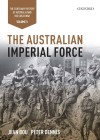The Australian Imperial Force
Written by: Jean Bou & Peter Dennis
Melbourne: Oxford University Press, 2016
ISBN: 978-0195576801, 320 pp,
Reviewed by: William Westerman
This is the final volume of a five-book history of Australia in the Great War published by Oxford University Press during the war’s centenary years. Previous volumes have explored the war against the Germans, the war against the Ottomans, the war in the air and the home front. This book completes the picture, doing away with battle altogether and examining the AIF as an organisation. The Australian Imperial Force covers the AIF’s administrative, compositional and organisational history. True to the aim of the series, it has not told a new story, but has told an old story in a new way, and as the concluding book in the series, Jean Bou and Peter Dennis have rounded off the series very well.
This is not a book for every reader interested in military history. Those looking for a more kinetic re-telling of the Australian Imperial Force’s story will need to look elsewhere. The Australian Imperial Force discusses what was required to raise, train and sustain five infantry and two mounted divisions on deployment for four years. For anyone interested in a more complete understanding of military organisations, this book is essential and brilliant.
The Australian Imperial Force is loosely chronological, although it is far more thematically- than narratively-driven, covering all the aspects of the AIF’s existence that did not directly involve combat. Through this approach the reader get a sense of the AIF as a living organisation, the way it organised for battle, from where it drew its officers and how it sustained and administered itself over four years. It leaves no stone unturned, even including discussions about the AIF’s postal service.
One of the most impressive aspects of the book is the depth and scope of demographic survey in Chapter Four, which provides a much more extensive examination of the composition of the AIF than most other works, allowing for some fascinating deductions. For instance, the book charts with accuracy the stated religious affiliations of monthly enlistments, thus assessing the impact of perceived sectarian events such as the 1916 Easter Rising in Dublin or the two conscription plebiscites. The work done in preparing this survey was immense, and is a great credit to the authors for their audacity and diligence in undertaking such a task.
Beyond that, many obscure aspects of the AIF’s organisation have been highlighted, such as the composition of AIF Headquarters in London or the details of how the AIF dealt with the issue of pay. Bou and Dennis assess the politics and practicalities of William Birdwood as GOC AIF, as well as exploring the issue of whether the AIF was too large. The third contributor, Paul Dalgleish, provides an appendix on the AIF’s record-keeping. In keeping with the nature of the book, if you are a reader who enjoys administrative historical detail, this will be fascinating–if not, then it will likely be of little interest. A final issue addressed in The Australian Imperial Force is the events after the Armistice, particularly repatriation, which is often neglected in operational histories of the First World War. The concluding chapter on the legacy of the AIF provides a fitting end to the series as a whole. For all its strengths, it must be said that the book is a little dry to read in some places. This is to be expected for a serious work of this type, but it might turn off a casual reader. There is also a lack of consistency in the focus of the book, as it switches from organisational history to demographic surveys to issues of command and administration, which makes any overall thread difficult to follow.
Nevertheless, The Australian Imperial Force presents an honest look at a young nation attempting to put together an expeditionary force for active service in two major theatres of war, each with its own challenges. A final positive for the book is that it does not neglect the Middle East theatre of operations, providing ample discussion of AIF organisation and administration in Egypt, the Sinai and Palestine. This is a book for those seriously interested in the Australian Imperial Force; a rigorous exploration of what is required of a nation such as Australia to send a large expeditionary force overseas and sustain it for several years.

